

The microscope is one of the essential lab instruments that help to examine the objects and specimens that cannot be seen with our naked eyes.[1] The optical instrument magnifies the specimen to multifold, making it visible to our eyes.
Because of their ability to produce high-quality, highly-resolved, clear, and magnified images of specimens, microscopes are extensively used in many areas. It has applications in life science (such as microbiology, molecular biology, and cell biology), chemistry, manufacturing, petrology, and even coin collection.
Various microscopes have been designed and are available in the market to serve different applications. Each microscope has different features, functions, and operational capabilities. Thus, purchasing a microscope is a mind-boggling process to decide which microscope will be suitable for your lab workflow and applications.
This microscope purchasing guide briefly covers the types of microscopes and their features. It also highlights the factors to consider when acquiring the “right” microscope.
Below is a list of five types of microscopes, their working principles, and their applications:[2]
A simple microscope has a single convex lens with a small focal length. It’s called a simple microscope because it has only one lens for the magnification of objects.[2]
Applications include:[2]
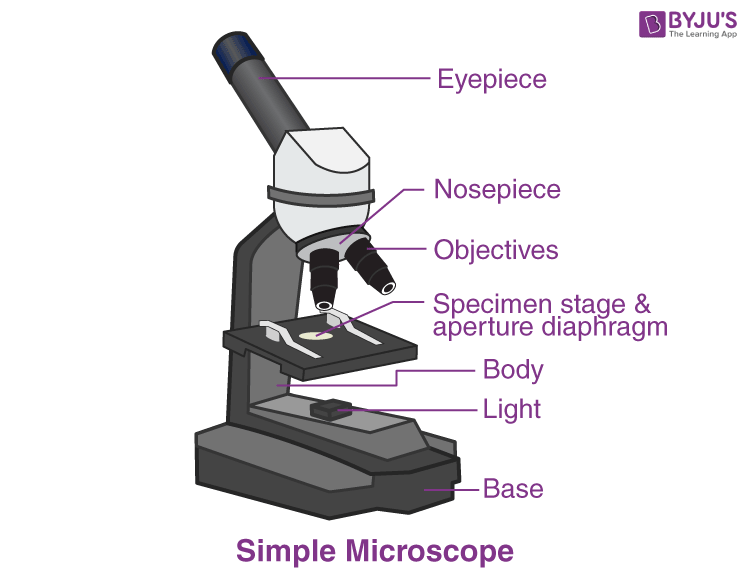
Figure: An illustrative diagram of a simple microscope.[2]
The compound or biological microscope combines two optical parts (objective lens and eyepiece) and lenses.[2] The microscope has more than one lens, so it helps to observe the small specimen and not their details at higher magnification.
It is used in forensic labs, metallurgy, schools, wastewater treatment plants, histology and pathology, and veterinary labs.[3]
The samples that can be studied using the microscope are cheeks cells, bacteria, algae, viruses, blood cells, parasites, and thin organ sections.[3]
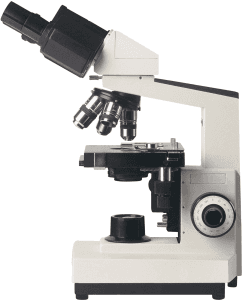
Figure: The image of a compound microscope.[4]
In an electron microscope, the light source is a beam of electrons. It can magnify and look at specimens in nanometers, and it also requires careful sample preparation. The samples should be as thin as 100 nm for the electrons to pass through and generate the micrograph or image.[2]
Electron microscopes are of two types: scanning electron microscope and transmission electron microscope. The microscope is used for the following purposes in different labs and industries[2]:

Figure: A schematic diagram of the two types of electron microscopes.[2]
It scans the interactions between the probe and specimen. The three most common types of scanning probe microscope are near-field scanning optical microscopes (or scanning near-field optical microscopy), atomic force microscopes, and scanning tunneling microscopes.[2]
The microscope helps to study and analyze different properties of the samples and specimens, such as electrical and magnetic properties.
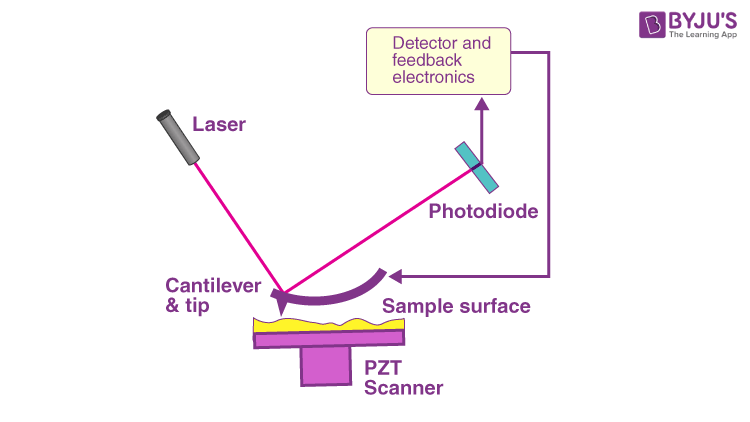
Figure: A schematic diagram of a scanning probe microscope.[2]
A stereo or dissecting microscope provides a 3-dimensional view of a specimen or sample and has a separate objective lens and eyepiece.[3]
It’s mainly used for larger samples visualized by naked eyes and held in hands, such as small plants, animal specimens, and soil samples.
Some applications of the microscope are[2]:
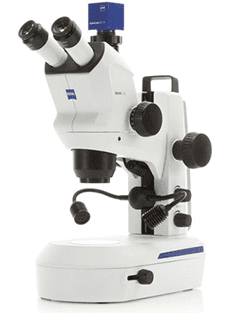
Figure: The image of a stereo microscope.[3]
The microscope uses polarizing light with reflected or transmitted light to visualize the objects. It has both a polarizer to allow the passage of only a certain light wave and an analyzer to illuminate the sample by determining the amount and path of light to the samples. It’s most suitable while working with birefringent materials.[3]
The microscope is mainly used by petrologists, geologists, chemists, and pharma industries in different assays.[3]
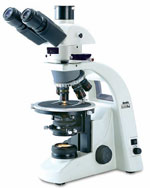
Figure: An image of a polarizing microscope.[3]
In this microscope, the condenser and objective lenses are present above the specimen stage, pointing down, while the turret and objective are present below the specimen stage, pointing upwards. The system is in the opposite order of the normal microscope.
The inverted microscope provides magnification of 40x, 100x, and often 200x and 400x.[3] They are used for live-cell imaging, in-vitro fertilization, microbiology, neuroscience, and cell biology studies. Commercially, these microscopes are available as biological inverted microscopes or metallurgical inverted microscopes.[3]
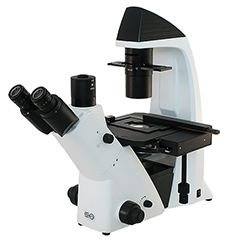
Figure: An image of an inverted microscope.[3]
Because microscopes have different designs and applications, certain features and factors will help narrow your choices and get you the right microscope for your experiment.
Compound microscopes generally have 3-5 objective lenses to magnify objects from 40x to 400x,[5] and some can go up to 1600x magnification. Thus, the microscope is suitable for observing tiny organisms and cells, such as bacteria, pond scum, blood samples, and water organisms.[6] The microscope helps in getting into details of the specimen with greater magnification.
However, the sample preparation for a compound microscope requires a long time because of mounting and frequent staining procedures.
The stereo microscope has a lower magnification compared to the compound microscope. They can magnify objects up to 5x-60x. However, 160x magnification can be obtained using a stereo microscope and employing different microscope accessories.[6]
Because of their lower magnification, stereo microscopes are suitable for studying larger specimens or organisms such as beetles, bugs, gems, soil, and small plants and animals.[6] This microscope requires minimal or no specimen setup and thus can also be used by young children to learn the workings of a microscope.
Many types of lights are attached to microscopes designed to serve specific purposes. Below is a list of four light sources with features like heat, lamp life, and color accuracy to be considered before purchasing a microscope.[5]
A microscope’s magnification is decided by two factors: the microscope’s objective lens and eyepiece. So, to obtain the total magnification power of a microscope, the values of these two factors are multiplied.[5]
For example, if you observe through a microscope with 10x eyepiece and 10x objective lens, its total magnification will be 10x X 10x = 100x.
Typically, a compound microscope comes with four objective lenses: 4x, 10x, 40x, and 100x; however, five objective lenses are also available in some.
Microscopes generally come with three types of eyepiece: monocular, binocular, and trinocular. Monocular microscopes have one eyepiece, binocular microscopes have two, and trinocular microscopes have two eyepieces with a third eyetube to fix a camera in high-end experiments for digital imaging, teaching, or demonstration purposes.[7] It can also be a digital video microscope with an LCD screen.
Quality is one of the essential factors that you should note while purchasing a microscope. It’s mainly checked in terms of the light source or illumination, construction, and lenses fixed in the microscope.[8]
A variety of microscopes are available on the market, ranging from cheap plastics to metal bodies which provide strength and increase durability.[8] Microscopes with weak builds break easily; thus, purchase from a verified vendor or seller to ensure you’re getting good quality.
Before purchasing a microscope, think about what workflow you need to perform. This will help you to choose the right microscopy for your experiments.
When working with small specimens, a compound microscope is needed. But different compound microscopes work on different microscopy methods. So, how do you choose the right one?
Based on common suggestions, if you are working with environmental samples, such as soil and water, use a microscope with the dark-field microscopy method; if analyzing live blood samples, you need phase-contrast microscopy; and if you are working on medical or clinical samples, use a high-throughput microscope, such as one with epifluorescence microscopy.[9]
However, working with large samples, such as those that the naked eyes can see, requires a stereo microscope. And based on your applications (like dissection, forensic experiments, or repairing circuit boards), you might need a stereo microscope with different stands, that is, a microscope with a Double-Arm Boom Stand, Ball Bearing Boom Stand, or Table Stand with Pillar.[9]
Microscopes are essential laboratory instruments that help in various laboratory workflows and assays. Different microscopes are available today, designed to serve specific applications, such as visualizing cell and cellular components.
You should consider several factors when purchasing a microscope, especially if you want to choose the right microscope. For example, the microscope’s magnification range, the type of sample you are working with, your budget, the microscope’s quality, and the purpose for which you need the microscope.
If you’re looking for a high-quality microscope for your lab work, look nowhere other than Conduct Science because we have a wide range of microscopes with high-tech features and updated software, including our desktop binocular stereo microscope, which is currently on sale.
